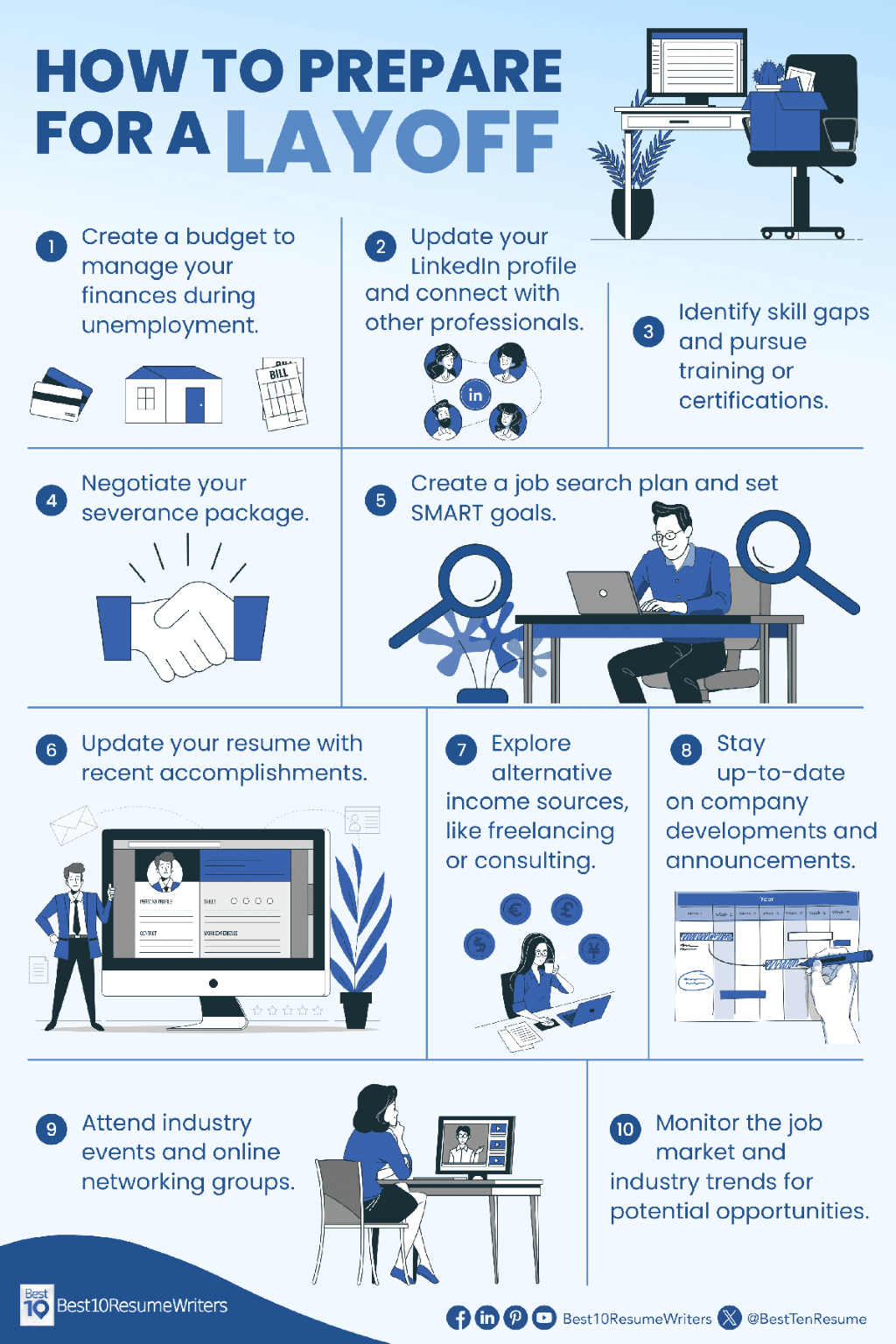It is inevitable for a company to impose a layoff no matter how extensive it is, and having a successful business does not mean that there are no challenges and hardships. In fact, even well-known corporations like Meta and Tesla lay off employees if they see that cutting down on overhead will save them money. Businesses have ups and downs that affect not only the employers but also the employees.
A layoff can be overwhelming if it catches you off-guard, but being aware of the warning signs of layoffs can help you prepare for and overcome them. This article will walk you through everything you need to know about layoffs.
What is a Layoff
A layoff is the process of involuntary termination of employment, which usually occurs due to technical or financial difficulties. Unlike traditional termination, this approach is generally not related to the performance and productivity of employee. Companies denote layoff as downsizing or reducing workforce that they consider a smart way of cutting costs or adapting to market changes. Since layoffs are initiated by employers, laid-off employees can receive just compensation.
Related Article: The Impact of Job Loss—and Ways to Cope with It

Reasons for Layoffs
There are numerous reasons a business might need to let go of one or more employees. Here’s a list of common situations that force employers’ hands to carry out a layoff:
Financial Difficulties
The most common reason for layoffs involves financial crisis. When companies are facing financial hardships, they will be forced to cut down their workforce. Employees’ salary takes a huge percentage of the company’s revenue and laying off will help them reduce expenses. Financial difficulties can be caused by revenue declines, heightened competition, high operating costs, and external economic downturns, among others.
Company Relocation
Relocating a business can be due to various reasons. It can be for the sake of space expansion for growing organizations or reducing operational costs by getting nearer to the customers. There can be employees who cannot relocate especially if it is way too far from the original site. Employers may eventually need to lay off those employees for them to look for new jobs.
Mergers and Acquisitions
Merger is the process of unifying the operations of two organizations into one. There may frequently be a conflict between the two companies’ respective job roles or functional overlaps. The merged business might have to let some people go to streamline operations and get rid of redundancies. This is because the company could only require one employee from the same organization to carry out a specific task rather than two people from different companies.
On the other hand, an acquisition occurs when one business buys another. Employees at the original company might experience a layoff because an acquisition typically entails new leadership, business strategies, and changes to corporate regulations. Employees that perform the same or a comparable job to others from the firm making the purchase may also be let go by the business.
Outsourcing
Outsourcing is a process in which an organization employs a third party to carry out duties, manage operations, or offer services for the organization. A company may opt to lay off current in-house employees if it decides to outsource a task they currently carry out since it is more cost-efficient that will help the company to reduce expenses.
Business Closing
In worst-case scenarios, when a company fails to deal with financial difficulties, it can lead to a business shutdown. In this case not only a few employees, but all, will experience layoff.

Who Usually Gets Laid Off First
Most companies follow the “last in, first out” structure when it comes to layoffs. Employees who have worked for one year or less are more likely to get laid off than long-term employees. Recruiters also have higher chances of getting laid off since a company that is reducing its workforce will obviously not look for new talents.
Signs of Layoffs
While layoffs are a common occurrence in the workplace, not knowing when it will happen can cause anxiety and stress. Fortunately, there are warning signs that you can notice to help you prepare for what’s to come. Here are some signs of layoffs to look out for:
Decrease in Volume of Workload
As an employee, this will be the most noticeable change that might be a sign of a layoff. If you used to have projects that come your way on a regular basis that suddenly stopped or decreased, then you should immediately consult your direct supervisor. It doesn’t automatically mean that you are about to be laid off since it can also be due to the natural order of workflow. Instead, asking your supervisor would be the best move to confirm the cause of the sudden change.
Hiring Freeze
When a company stops recruiting new talents, it instantly gives off a negative impression. Hiring new sets of employees is a sign that a company is continuously growing. Conceding to a hiring freeze shows that the company cannot sustain the growth anymore and most likely will impose a layoff.
Shift in Manager’s Behavior
Managers are people with real feelings. Therefore, when they learn that someone is going to be fired, they often refrain from communicating with them. This is to assuage one’s guilt. So, if you noticed shifts in your boss’ behavior, then you might want to prepare for a layoff.
Discontinued Projects
To cut the company’s expenses, employers might decide to discontinue projects that are not on top priority. If you and your team are working on a project that was stopped, the risk of being laid off is high.
Resignations of Upper Management
Those who have higher positions know if the company is not doing good. A decline in the financial status of the company is not favorable for the executives. They will eventually leave before things become worse.

How to Prepare for a Layoff
1. Negotiate your severance package.
Employers usually offer severance packages and you can take advantage of that by negotiating on what you’d like to receive. Since you will be laid off, it is only fair to receive just compensation. You can ask for more severance pay or assistance in securing a new job.
2. Update your resume.
Applying for a new job would automatically be one of your options after being laid off. Remember that a top-quality resume can be your weapon against other applicants that are also applying for a job.
3. Manage your expenses.
Remember that the risk of unemployment is present until you secure a new job before or after being officially laid off. Try to cut your expenses and set aside some savings just to prepare for the worst-case scenario.
4. Know your next steps.
You will have tons of options that you can choose from to what you should do next after being laid off. You might consider a career change, try freelancing, or simply search for a new job. Just bear in mind that your decision will affect your career so choose a path that you will less likely regret.
Bonus Tips:

Download the Tips on How to Prepare for a Layoff Infographic here.
Turning Layoffs into Opportunities
It is normal to feel scared when you’ve become aware of the signs of an impending layoff. Just keep in mind that panicking and dwelling on it will not help you overcome it. Here’s a quick rundown on how you can turn layoffs into opportunities:
1. Look back in retrospect.
This gives you a rare chance to reflect on your career before you were laid off. Use this opportunity to reflect on what your goals are and if you’re still in line with them.
2. List your professional highs.
What have you achieved so far in your career? What did you enjoy most? Take note of your successes, since they can help you question your motivations and priorities, as well as strengths and weaknesses.
3. Make resolutions moving forward.
This allows you more time to think whether you want to stay in an old career to further enhance it, or you need to move into something new and better. The choice to rewrite your career plan and how you will achieve it depends on you.
4. Update your professional portfolio.
Spend some time to gather your recommendation letters, testimonials from former employers and colleagues, and samples of works that generated positive remarks.
5. Update your resume.
To achieve a fresh look, you need to give your resume a makeover. Highlight your experiences and accomplishments by using keywords or phrases to pinpoint your skills and abilities. Through your resume, you can convince a prospective employer that you are qualified for the job.
6. Expand your network further.
Any networking activity should be focused on a specific target, which is to continue growing your career. This includes getting introduced to someone so you can make a connection or learn about potential opportunities in the process.
Hire the Best Resume Writing Services to Help You Navigate Your Job Search
Severance of employment, whether you anticipated it or not, can surely be distressing. Hence, it’s imperative to be alert at the first signs of layoffs and be prepared a few steps ahead of everybody else.
We at Best 10 Resume Writers want to ease your concerns by creating stepping-stones that you will need to start your new journey. We can assure you that you will get your hands on a top-quality resume that will help you land your desired job. You can check our exhaustive list of the top resume writing service providers or our blogs for more career advice today.





